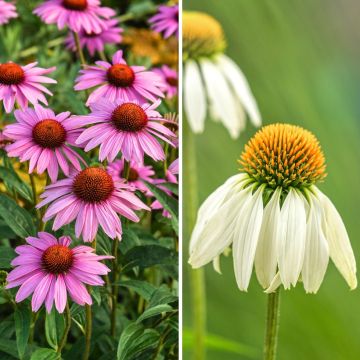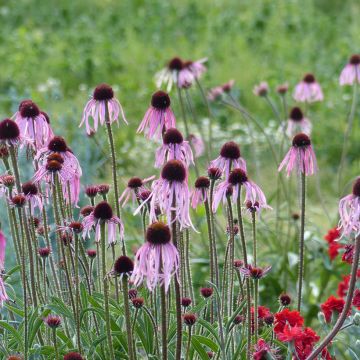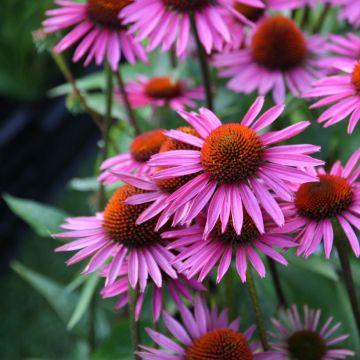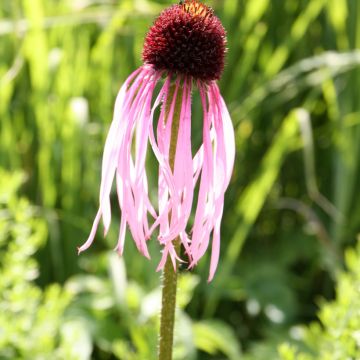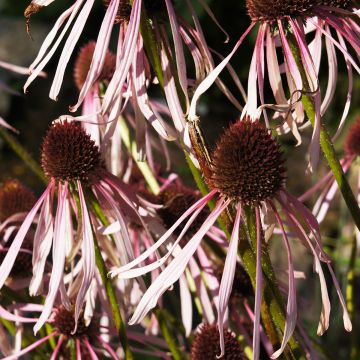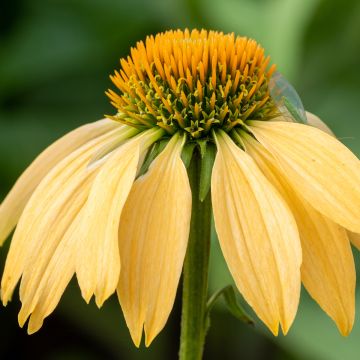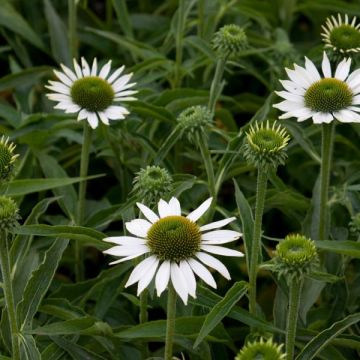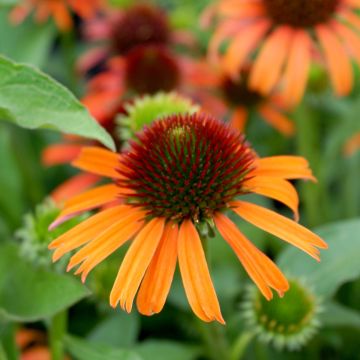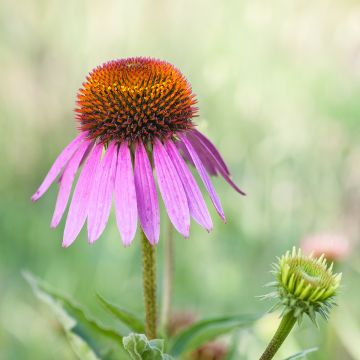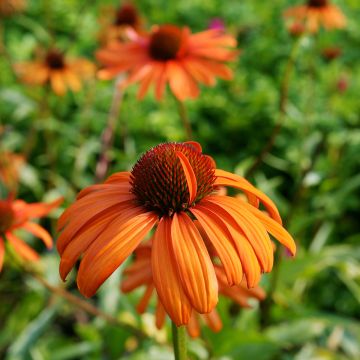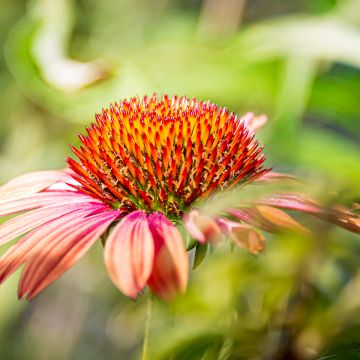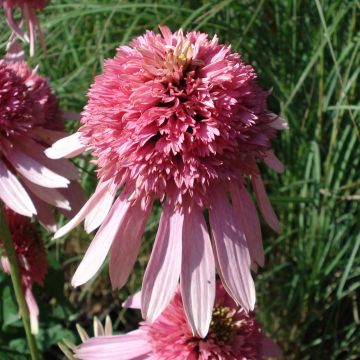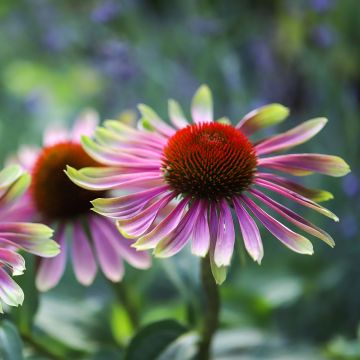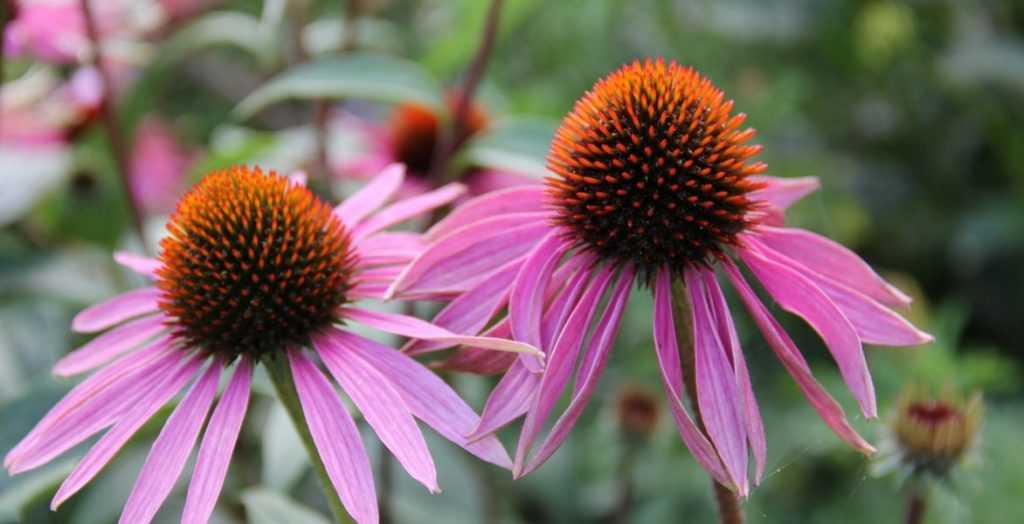
Echinaceas: Sowing, Growing and Care
Contents
Echinacea in a few words
- Radiant and colourful, the coneflower is the queen of summer!
- Its unique flowers, resembling large daisies in shades of pink, purple, yellow, orange, white or even green, bloom tirelessly throughout the summer without pause
- Extremely easy to grow, its only requirements are well-drained soil and a sunny position
- Remarkably hardy, Echinacea adapts to all soil types
- This is an essential perennial for contemporary prairie gardens, English-style mixed borders and floral arrangements!
Our expert's word
The Echinacea, also known as the Purple Coneflower, is utterly enchanting. Renowned for its numerous benefits in homeopathy and herbal medicine to boost the immune system, this medicinal plant truly has it all!
Shine a spotlight on summer with this stunning American beauty, which boasts an abundant and unconventional bloom!
Exceptionally striking, its large flowers with prominent, spiky centres—resembling simple daisies or tousled pom-poms—bloom tirelessly throughout summer in flowerbeds, from June until early autumn, standing firm against the wind.
A must-have in a natural garden or more refined settings, the Echinacea, at times subtle and at others vibrant, adapts to every whim and creative vision. Its solitary yet radiant flowers are classic staples in mixed borders, bringing exuberance, character, and whimsy—sometimes even a touch of tasteful eccentricity.
Its composite flower heads create vibrant fresh bouquets, while its centres lend themselves to strikingly graphic dried floral arrangements.

Echinacea purpurea
Each species is defined by its colour, the appearance of its ray florets, and the posture of its flowers—ranging from horizontal to drooping. From the ever-popular Echinacea purpurea to the Echinacea pallida, with its slender, strongly drooping petals, and even the unique yellow-flowered Echinacea paradoxa, or the more compact Echinacea angustifolia, there’s an Echinacea for every gardener! And that’s not even counting the countless cultivars and new varieties offering an endless array of shades—lavender-pink, cranberry-pink, purple, white, orange, yellow, and even green!
Extremely easy to grow and adaptable, this “hedgehog plant” will reward you with abundant blooms if planted in full sun in fertile, deep, loose, moist, and well-drained soil. A well-mannered plant, it stands firm in the wind and tolerates intense heat as well as occasional drought. It requires little watering.
Highly versatile and easy to pair, it forms lush clumps in just a few years, producing an exceptional profusion of blooms alongside perennials that, like itself, demand minimal care—such as ornamental grasses or dahlias. For a bold, eye-catching mix, pair it with Yarrows, Oriental Poppies, Daisies, Agastaches, annual Rudbeckias, Coreopsis, Globe Thistles, or Phlox. At the edge of a border, it shines alongside shrubby Salvias, dwarf Gladioli, or Daylilies.
Discover the Echinacea, this effortless summer perennial! With its bold presence, it creates wild, high-impact displays bursting with colour!
Botany
Botanical data
- Latin name Echinacea
- Family Asteraceae
- Common name coneflower, purple coneflower
- Flowering from June to September
- Height from 0.30 cm to 1.50 m
- Exposure full sun
- Soil type All types
- Hardiness -15°C
The Echinacea, also called purple coneflower, belongs to the Asteraceae family like daisies and asters. Although from a different genus, Echinacea is often associated with its cousin Rudbeckia, with which it shares its resemblance to large daisies with prominent centres: in Greek, Echinea means “hedgehog” due to its spiky central cone. This perennial, with its distinctive character, grows wild in open woodlands, dry plains, rocky hills and even roadsides in the central and eastern United States. Today, it thrives in all temperate climates. Hardy, it can be planted throughout France: originating from dry prairies, it has retained a great tolerance to sun, competition from other plants and some drought resistance. Echinacea is also extremely hardy: very cold-resistant, it withstands frost and temperatures well below -15°C.
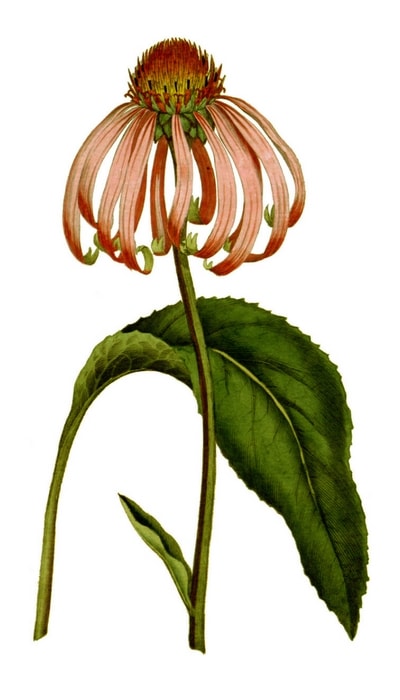
Echinacea purpurea
Nine perennial species make up the Echinacea genus, but successive hybridisations have produced many interesting cultivars varying in shape, height and colour. Some, like Echinacea purpurea ‘Avalanche’, bear flowers resembling simple daisies, while others like Echinacea purpurea ‘Pink Double Delight’ look like large, fluffy pompons. Each species owes its characteristics to the colour, appearance of the more or less long and thin ray florets, and the upright or drooping habit of the flowers. Four species are mainly found in our gardens. The most cultivated and fashionable in our latitudes is Echinacea purpurea, the typical species with purple-pink flowers: it is the hardiest and most floriferous. It is also one of the most used in herbal medicine. It includes over a hundred varieties, such as Echinacea purpurea ‘Magnus’, with exceptionally large and longer-lasting flowers than the typical species.
You can also find Echinacea pallida, whose flowers have thin, strongly drooping ray florets, and Echinacea paradoxa, which paradoxically is the only yellow-flowered species in the genus instead of the usual purples or pinks. Many cultivars and varieties result from crosses between Echinacea paradoxa and Echinacea purpurea, such as the magnificent Echinacea purpurea ‘Sunrise’ with pale yellow flowers.
Echinacea angustifolia, with red-pink flowers, is a compact variety; shorter than most other species, it does not exceed 60 cm.
From its thick base emerge in spring clumps of tall, slender yet sturdy stems with exceptional wind resistance. Echinacea has a very upright, more or less branched clumping habit, easily reaching 1 m in height, with a spread of 60 to 70 cm for the largest varieties. Its large, short black rhizome anchors itself slowly but surely in the soil. Its root is used in homeopathy to fight colds and boost the immune system. Somewhat slow to establish, Echinacea needs about two years to fully develop and perform at its best. If happy, it can even become invasive… The typical species can self-seed. Vigorous, purple coneflower can live for years if undisturbed. However, double-flowered cultivars have a shorter lifespan, are less hardy than the typical species and may be biennial.
Once well-rooted, this rhizomatous perennial grows over the years to form dense, floriferous clumps.
From June to October, depending on the variety, the sometimes branched stems bear solitary flower heads 2.5 to 12 cm in diameter of rare originality.
Conquering, radiant like stars, Echinacea flowers have a solar beauty that cannot be mistaken. While they resemble daisies, Rudbeckias or Heleniums, they have their own characteristics. They all feature a dark, hemispherical to slightly flattened central cone that can sometimes be very prominent. The central part of the flower head consists of pointed, tightly packed florets in green, brown or violet, interspersed with yellow or brown scales giving the centre a spiky appearance in rosy brown, gold or orange.
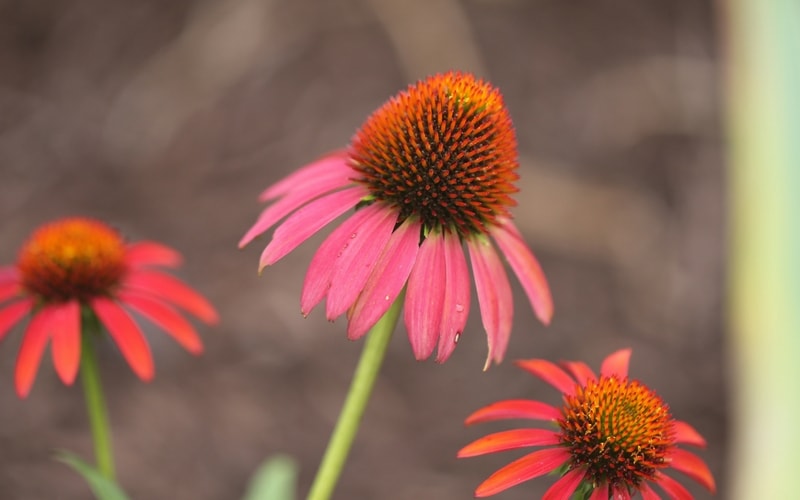
White cultivars have a greenish-yellow centre. It’s the anatomy of this scaly, pinecone-like centre that distinguishes Echinacea from Rudbeckia. Some varieties like Echinacea purpurea ‘Razzmatazz’ have very double, pompon-like centres giving the flowers a fluffy appearance. This spiky pompon is surrounded by a collar of long (3 to 9 cm) and thin ray florets, sometimes rolled, arranged in one or more rows, ranging from purple-pink to cranberry pink, candy pink to pale pink, purple to red, and even white, orange, yellow and apple green! The length, width and colour of the ray florets vary by cultivar. It’s the ray florets that determine the flower colour, offering complementary or contrasting hues with the large, domed centre. Some varieties like purple coneflower ‘Green Envy’ have bicoloured pink and green ray florets.
The more or less reflexed habit of these ray florets makes Echinacea so distinctive. From one species to another, the silky or shiny petals are sometimes so strongly reflexed they resemble a ruff, others spread almost horizontally or are only slightly drooping. In Echinacea pallida, the thin, drooping ray florets look like jellyfish tentacles. Some cultivars bear even more astonishing flowers: Echinacea ‘Ferris Wheels’ intrigues with its tubular florets that open and split at their tips.
The remarkably generous, colourful and fragrant flowering lasts all summer: flowers renew themselves continuously in the border. They emit a subtle honey fragrance very attractive to pollinators like bees and butterflies, intensifying as they bloom. The scent becomes even sweeter, more vanilla-like once the flower head is pollinated.
Purple coneflower is a much-visited plant! In autumn, faded flowers produce fruits, the achenes: the dark brown centre releases tiny seeds that can be harvested by simply running a finger over the cone. If stems are left uncut after flowering, the brown cones hanging from their rigid stems will extend the decorative effect into the dull season, and the seeds left in place will delight certain bird species like finches, goldfinches and tits in early winter.
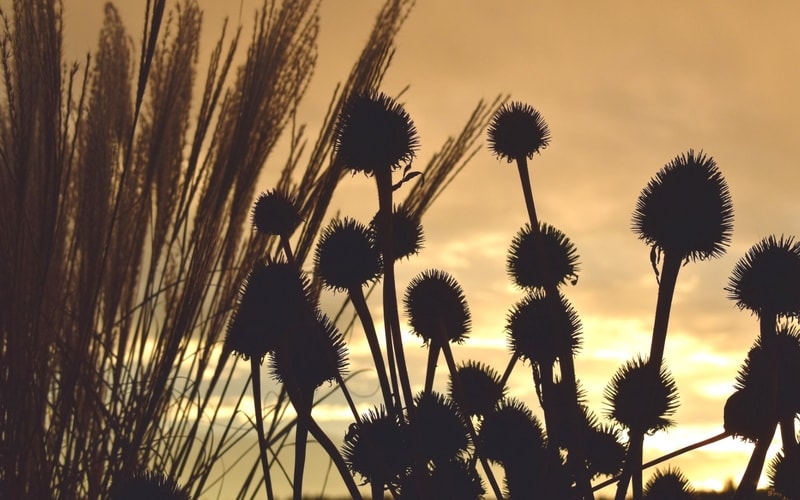
Leave your Echinaceas in place at summer’s end to enjoy their fabulous winter display
Echinaceas are highly prized in floral art; their striking large flower heads make lovely cut and dried flowers. Fresh flowers, long-lasting in vases, create beautiful summer bouquets full of solar energy, sparkle and flame. Their spiky mature cones are particularly graphic in dried arrangements.
Deciduous, Echinacea foliage resembles that of daisies and Rudbeckias. Its main appeal lies in its abundance. The upright stems bear narrow, dark green, oval to lance-shaped, slightly toothed leaves, smooth or more often covered in rough hairs. More numerous at the base, they are alternate and sparse towards the stem tips. The basal leaves, less elongated than those on the stems, are not very decorative. Once dried, the leaves release a vanilla scent.
Echinacea is an easy-going, uncomplicated, docile and fertile plant as long as it’s planted in full sun. While adaptable to all soils, it will thrive and reach gigantic proportions in fertile, deep, loose, fresh and well-drained soil. This sturdy plant fears neither wind, nor intense heat, humidity or drought.
Versatile, it brightens naturalistic borders, energises edges and enchants English mixed borders. Some reasonably sized varieties, like Echinacea ‘Southern Belle’, are also suitable for container growing. As it tolerates growing near roots without hindering its development, it can be planted near shrubs, provided they don’t shade it! Echinacea is very easy to combine with other low-maintenance perennials to create wild-looking, colourful scenes.
Once well-rooted in suitable soil, it requires no special care and shows excellent resistance to pests and diseases.
Echinacea (especially pallida, angustifolia and purpurea species) is a medicinal plant widely used in homeopathy and herbal medicine to treat wounds, skin eruptions, respiratory infections and boost the immune system.
Species and varieties
Colours, heights, and shapes abound in endless variations, with numerous cultivars now readily available. This family comprises many varieties with both double and single flowers. The choice becomes more complex among Echinaceas with pink, white, red, yellow, orange, or even green flowers! The defining features are the arrangement of the ray florets, with a simple or very double collar, evoking a demure daisy or a ruffled peony, and the colour of the rays—pure white, purple, violet-pink, antique rose, candy pink, yellow, orange, or green—that primarily guide the gardener. Cultivars with rather spectacular double flowers, such as Echinacea purpurea ‘Razzmatazz’, are less robust than single-flowered Echinaceas.
Four species are commonly cultivated in our gardens: the standard species, Echinacea purpurea, is the most widespread, likely because it is also the hardiest. It boasts over a hundred cultivars. You’ll also find Echinacea pallida, whose flowers have slender, strongly drooping rays, and Echinacea paradoxa, paradoxically the only species in the genus with yellow flowers instead of the usual purple or pink hues. Many cultivars and varieties stem from crosses between Echinacea paradoxa and Echinacea purpurea. Echinacea angustifolia is a compact variety that rarely exceeds 60 cm in height.

Echinacea purpurea - Purple Coneflower
- Flowering time August to November
- Height at maturity 80 cm
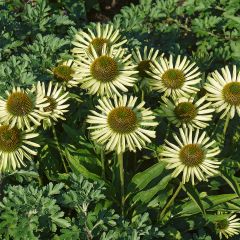
Echinacea purpurea Avalanche - Purple Coneflower
- Flowering time August to October
- Height at maturity 50 cm
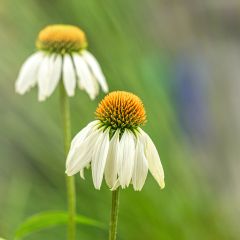
Echinacea purpurea Alba - Purple Coneflower
- Flowering time August to October
- Height at maturity 80 cm
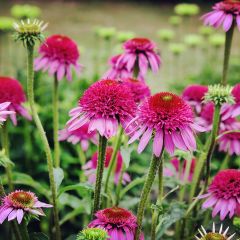
Echinacea purpurea Catharina - Purple Coneflower
- Flowering time August to October
- Height at maturity 80 cm
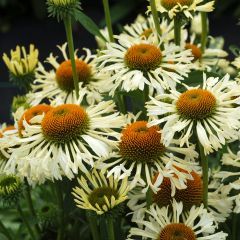
Echinacea purpurea Ferris Wheel - Purple Coneflower
- Flowering time August to October
- Height at maturity 60 cm

Echinacea purpurea Razzmatazz - Purple Coneflower
- Flowering time August to October
- Height at maturity 1 m
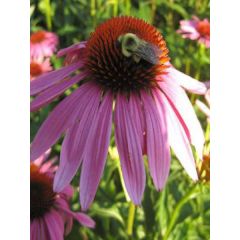
Echinacea purpurea Magnus - Purple Coneflower
- Flowering time August to October
- Height at maturity 1 m
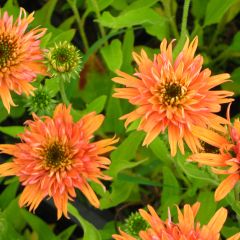
Echinacea purpurea Colourburst Orange - Purple Coneflower
- Flowering time August to October
- Height at maturity 50 cm
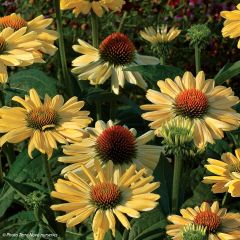
Echinacea purpurea Aloha - Purple Coneflower
- Flowering time August to October
- Height at maturity 90 cm
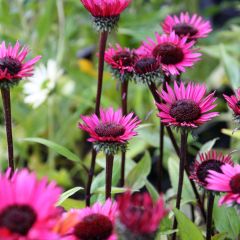
Echinacea purpurea Fatal Attraction - Purple Coneflower
- Flowering time August to October
- Height at maturity 70 cm

Echinacea purpurea Cranberry Cupcake - Purple Coneflower
- Flowering time August to October
- Height at maturity 35 cm
Other Interesting Varieties
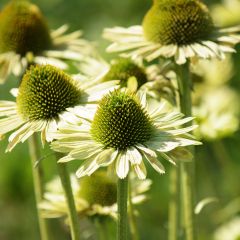
Echinacea purpurea Green Jewel - Purple Coneflower
- Flowering time July to October
- Height at maturity 60 cm
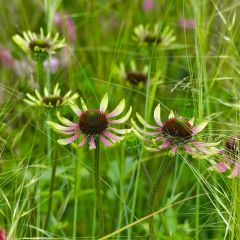
Echinacea purpurea Green Envy - Purple Coneflower
- Flowering time August to October
- Height at maturity 50 cm
Discover other Echinacea - Coneflower
Planting
When to Plant Echinacea?
Echinacea can be planted in spring from March to April or in autumn from September to October, avoiding periods of frost and drought.
Where to Plant Echinacea?
Very easy to grow, Echinacea thrives almost anywhere in France, even in coastal areas. In cold and damp regions, mulching is recommended. Highly hardy (well below -15°C), it resists frost but struggles with extreme cold. However, it tolerates heatwaves well.
Once well-established in a suitable spot, it flourishes year after year, becoming increasingly floriferous—provided it isn’t disturbed. Its roots should be left to spread undisturbed, as it dislikes transplanting. Double-flowered cultivars, however, have a shorter lifespan, are less resilient than the species type, and may behave as biennials.
If happy, it can even become invasive… The species type, Echinacea purpurea, may self-seed freely.
Choosing the right location at planting is therefore essential: give it ample space!
While it can tolerate light shade, this sun-loving plant demands a sunny position. Whether in borders or on gentle slopes, it will adapt! Some compact varieties like Echinacea ‘Avalanche’ or Angustifolia are ideal for container growing.
It accepts all soil types, neutral and moderately moist, but truly thrives in deep, fertile soil. It dislikes waterlogged conditions: winter flooding is fatal. It requires very well-drained soil.
Exceptionally robust, it fears almost nothing: neither diseases, nor harsh weather, nor frost, nor strong winds (its stems remain unbent), nor drought, nor intense heat, which it tolerates temporarily.
Versatile, it suits all garden styles, excelling as a mid-border plant, backdrop, or in flower beds. Against a backdrop of climbing roses, clematis, and grasses, pair it with other low-maintenance perennials in bold hues like Yarrow, Dahlias, Asters, Oriental Poppies, Delphiniums, Agastache, Rudbeckia, Lupins, or Phlox.
How to Plant?
Slow to establish, once settled (after about two years), it rewards with longevity and increasingly abundant blooms. Planting it to match its floriferous nature is key. It prefers soil that stays cool in summer, especially in early years (mature plants tolerate drought better) and well-drained. It dislikes waterlogged winter soils. The soil should be deep and loose to encourage root development. It struggles with overcrowding: give it space!
Above all, the soil must be rich in organic matter to support flowering. In poor soils, it will never thrive.
- Loosen the soil thoroughly.
- Plant in a mix of compost, well-rotted manure, and garden soil.
- Allow 5-7 pots per m²—ample for this vigorous perennial’s spread.
- Space plants 25–30 cm apart.
- Once established, avoid disturbing them. Proper growth and flowering begin in the second year.
- Mulch in spring (pine bark works well) to retain moisture, ensuring prolonged blooms.
- In spring, protect young shoots from slugs and snails—fern-based repellents can help.
- Echinacea loves fertile soil: feed regularly with fertiliser to boost growth.
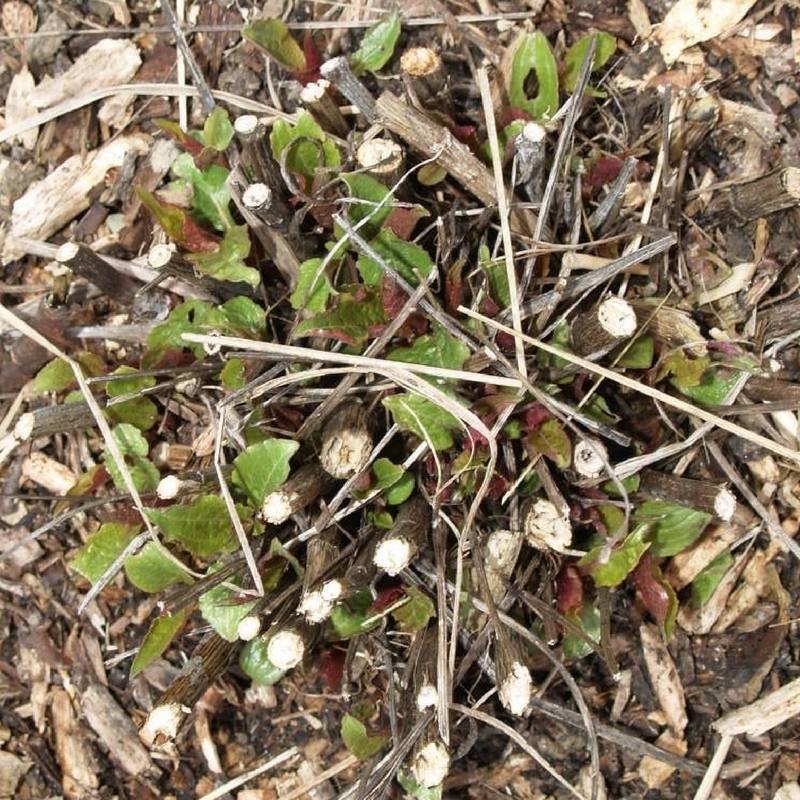
By March, Echinacea awakens—protect new leaves from slugs!
Container Growing
- Choose compact varieties.
- Mix potting soil with garden soil.
- Water regularly in summer, but avoid overwatering.
For more on planting Echinacea, explore our guides: “How to Plant Echinacea” and 6 Secrets to Growing Echinacea Successfully
Maintenance
Highly disease-resistant, once well-established, Echinacea requires little care and proves to be a trouble-free perennial with robust health. Provided the soil remains well-drained, sufficiently nourishing and cool in summer.
- Remove flowers as they fade to encourage further blooming.
- Cut back remaining stems to 15 cm from the ground in October to prevent invasive self-seeding (or create a dried bouquet). Alternatively, prune in early spring if you’ve left some spent stems standing – their striking silhouettes add winter interest to borders.
- Apply mulch in May to maintain adequate soil moisture during summer.
- Add compost in autumn or spring.
- Water during prolonged drought – though it tolerates heatwaves remarkably well.
- Mature plants may become susceptible to powdery mildew and aphid infestations.
- Older specimens may produce sparser blooms. After 5 years, divide oversized clumps in spring or autumn – but only if the plant shows signs of decline, as Echinacea dislikes root disturbance.
Potential Diseases
With few vulnerabilities, it has scarce enemies: gastropods during early growth stages and powdery mildew as the plant matures.
Propagation
Dividing the clump is possible but extremely delicate, with a high risk of killing the plant: it does not like having its fragile rhizome disturbed. Root cuttings are feasible but equally perilous. Since Echinacea seeds very easily, sowing remains the least tedious and especially the least risky method.
Sowing Echinacea
This is the simplest method: this perennial is very easy to grow from seeds. Sow in spring using fully ripe seeds harvested in autumn as soon as they turn brown, before they fall, or with purchased seed packets.
- Store them in a cool place for a few weeks before sowing to encourage germination.
- Sow the seeds in spring in a mix of compost and garden soil, barely covering them—vermiculite works well.
- Place the tray in a warm propagator at 15-20°C.
- Water regularly but avoid waterlogging the substrate.
- Germination takes 2 to 4 weeks.
- Once seedlings have two true leaves, transplant them into individual pots.
- Plant them out in autumn or the following spring when the seedlings are well-established.
- Flowering will occur from the second year onwards.
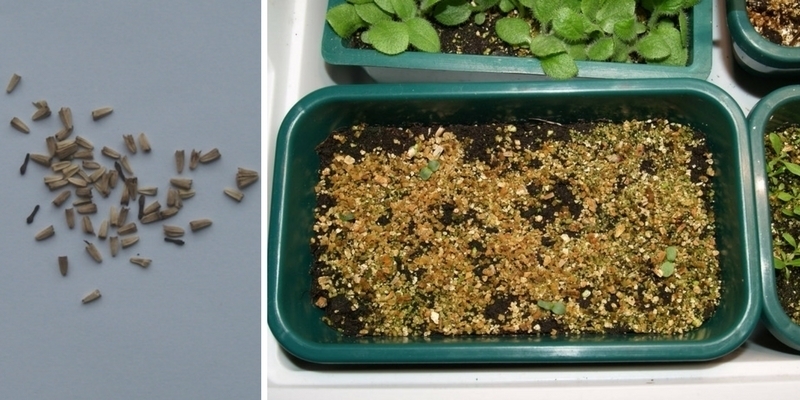
Echinacea seeds and seedlings: germination occurred within a week using a heated propagator.
→ Learn more in our tutorial: How to Sow Echinacea?
Association
Versatile and easy to combine, Echinacea is even inspiring for creating a naturalistic-style garden, or a mixed-border in the spirit of cottage gardens with other upright perennials requiring little care and maintenance. Yet, with its long and graceful stems, it also brings elegance and originality to more sophisticated spaces.
Some compact varieties, such as Echinacea ‘Southern Belle’, are also well-suited to container growing. Echinacea pairs effortlessly with other low-maintenance perennials to create wild and vibrant displays.
Planted en masse rather than alone, it gives structure to a border with its strong presence, whether providing contrast or in graduated or monochromatic shades of purple, pink, yellow, or white. We love pairing its intense colours with complementary hues for a bold and playful effect—think crimson/blue, orange/peach, or white/purple. For an explosive mix of strong tones, combine it with Yarrows, Oriental Poppies, Shasta Daisies, Agastaches, Rudbeckias, Coreopsis, Echinops, or Phlox. At the front of a border, it works wonders alongside shrubby Salvias, Dwarf Gladioli, or Daylilies.
When paired with shrubs boasting fiery foliage (Euonymus) and late-flowering perennials (Asters, Dahlias, Snapdragons, Heleniums, Autumn Stonecrops…), whose foliage develops in summer, it heralds the fiery hues of autumn.
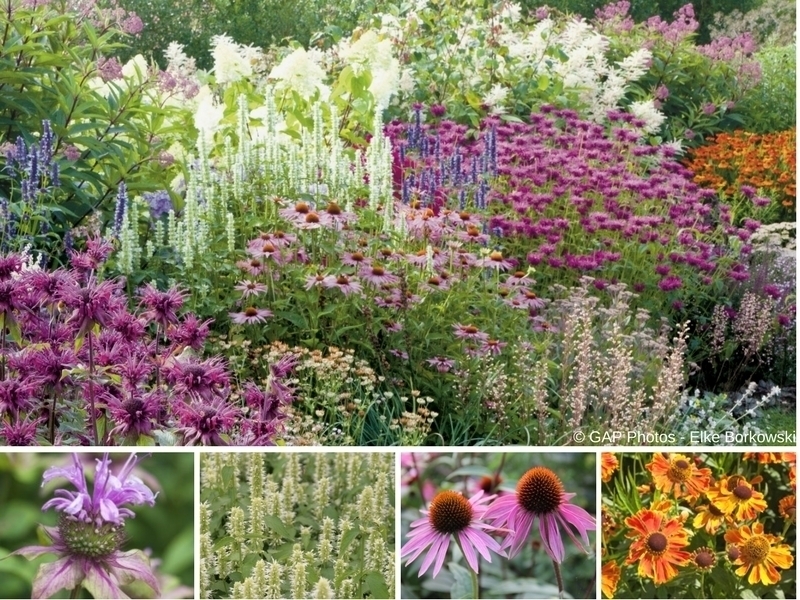
Another example of Echinacea pairing, with Monarda fistulosa menthifolia, Agastache ‘Alabaster’, and Helenium ‘Waltraut’
To soften the effect, use—or overuse—the silvery or blue-toned foliage of Artemisias or Santolinas. Grasses and airy perennials like Gaura or Baby’s Breath will add softness and movement, contrasting with Echinacea’s more rigid form.
It also makes the perfect companion for late-flowering climbing roses, creating exquisite late-summer scenes with an exuberant foreground.
Need a little extra inspiration? Check out our guide: “Echinacea or Purple Rudbeckia: 7 Beautiful Pairing Ideas”
Useful resources
- Discover our amazing range of Echinaceas: we have all the varieties!
- Follow Ingrid’s advice on our blog to create a beautiful perennial border
- Because sowing Echinaceas is easy: choose from our seeds!
- Sowing Echinaceas? A great way to brighten up your garden on a budget!
- Check out our buying guide Choosing an Echinacea
- Also discover our advice sheet on slow-establishing plants
- Learn all about planting Echinaceas in our advice sheet: 6 secrets for successful Echinaceas
- Echinaceas in all colours: 5 pink Echinaceas for a summer-flowering garden; 5 orange-flowered Echinaceas to discover; 5 yellow Echinaceas
Frequently asked questions
-
Is it true that dividing Echinaceas is not recommended?
Dividing the clump is possible but extremely delicate, with a high risk of killing the plant: it dislikes having its fragile rhizome disturbed. This is why we indeed advise against it. Sowing remains the least tedious and above all the least risky operation. You may collect self-sown seedlings or harvest the year's seeds if available.
As the plant ages, it may become more prone to powdery mildew, more susceptible to aphid attacks, and produce sparser flowering. After about 5 years (no sooner), in autumn, divide only the most substantial clumps. Resort to division only if the plant shows signs of decline, as Echinacea strongly dislikes being disturbed.
- Subscribe!
- Contents



































